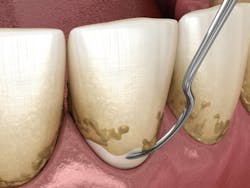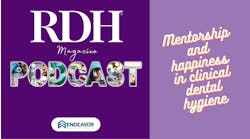Editor’s note: This is part three of a four-part interview series with Tim Donley, DDS, MSD.
Anne Rice: I have heard you speak about chronic inflammatory periodontal disease (CIPD). Inflammation anywhere is bad; medicine understands, but we (dental professionals) are inadequately managing this. Please elaborate.
Tim Donley: It is abundantly clear to medicine that while inflammation does not necessarily cause the chronic diseases of aging, the diseases that rob people of the quality and quantity of life as they age, inflammation is clearly the fuel that drives the development and progression of disease.
Medicine also fully embraces that controlling sources of systemic inflammation is an important strategy for systemic disease risk reduction. We know what is on the list of health promoting behaviors: stopping tobacco use, diet and exercise, adequate sleep, watching your blood pressure and blood sugar, cholesterol, and stress, and cutting down on alcohol consumption. It’s time to add keeping the mouth relatively inflammation free over our lifespan to that list.
From this interview series:
- Dentistry's narrative has failed. How should we change?
- 6 questions to get your dental office practicing evidence-based care
When CIPD is present, the local host response to the initiating pathogenic biofilm results in dissolution of collagen. The bone is mostly collagen. That is why bone loss and pocketing are hallmarks of CIPD. We need to start looking beyond the pockets and the loss of teeth. Left untreated, CIPD results in loss of the connective tissue that supports and nourishes the lining epithelium. The lining epithelium ulcerates, which is why we see BOP. When present, keystone pathogens in the mouth and their local inflammatory mediators are released in response, then they find their way into circulation and travel wherever the blood flows.
There is now indisputable evidence that the mouth contributes significantly to the systemic burden of inflammation when CIPD is inadequately managed. Interestingly, the risk factors for the chronic systemic inflammation affected diseases that medicine tries to manage are the same risk factors we are concerned about with periodontal disease. When we address tobacco, blood pressure, cholesterol, blood sugar, weight, sleep, nutrition, and stress, we are helping medicine better address the huge public health problem with chronic systemic diseases.
Many in dentistry don’t even take blood pressure regularly, let alone counsel patients on obesity or blood sugar. Even worse, we in dentistry have become complacent with the erroneous assumption that some periodontal disease is normal or tolerable. Let’s step up our game, especially for patients who already have risk factors for CIPD and the associated systemic diseases—do more than just clean their teeth twice a year. We should accurately diagnose oral disease, offer treatment that maximizes the chance that the oral disease will resolve, and then help patients keep it that way.
Rice: You speak about sites in the treatment of CIPD. Can you tell me your philosophy and the science that goes with that?
Donley: CIPD is a systemic disease with site-specific presentation. We can describe the extent and rate of progression at the patient level via staging and grading. However, a preferred level of oral health is a dentition that is functional, esthetically pleasing to the patient, relatively free of any sites of disease, and maintainable as such.
We need to diagnose, treat, reevaluate, and manage CIPD at a site level. We now have an evidence-based definition of what constitutes a health site. Periodontal heath is defined as a site at which there is no evidence of inflammation, no ongoing attachment loss and optimal probing depth (a probing depth that is accessible by the clinical team and maintainable by the patient). Simply put, we treat sites that do not meet that definition.
We may treatment plan and code procedures on a sextant or quadrant basis, but we never lose sight of the fact that CIPD is a systemic disease with site specific presentation. That is not my philosophy—it’s what the current science says. This calls for clinicians to have a working knowledge of what constitutes a healthy site every time they plunge a probe into a sulcus. There should be no indecision as to what sites need treatment.
Rice: I love when you speak about removing and interrupting etiology. Please share more.
Donley: It is no longer just about removing the plaque and calculus. CIPD results when biofilm becomes dysbiotic. Biofilm is microscopic. It is only when biofilm grows to the point where we recognize it clinically that we call it plaque. Yes, plaque calcifies and forms calculus but calculus itself is also a microscopic term. It is only when calcified biofilm grows to the point where we can detect it clinically that we refer to it as “calculus.”
Not all biofilm forms plaque, not all plaque calcifies, and not all the biofilm that does calcify grows into clinically evident calculus. You can remove clinical evidence of plaque and calculus and health may be restored to a site. If you want to maximize the chance that health is restored, you need to remove any clinical etiology and then expose the affected surface (the tooth surface adjacent to which the definition of disease site is met) to a method or combination of methods that also interrupts any microscopic etiology.
While we can use visual and tactile evidence to determine the presence or absence of plaque and detectible calculus, we currently have no way of determining if microscopic etiology is present. Until we have better diagnostic methods, we should assume that surfaces adjacent to sites where disease is present are covered with microscopic etiology and treat as mentioned above. Thus, the only way we can be assured that microscopic etiology has been adequately interrupted is if we exposed every square millimeter of the affected surface to a method or combination of methods capable of interrupting microscopic etiology.
We no longer want to aggressively (or inadvertently) remove tooth structure. We have known for at least 30 years that we do not want to achieve glassy-smooth surfaces. Science has established that we want the opposite of what many of us were trained to achieve. We want to preserve cementum since biofilm is not deeply embedded in the cementum as originally thought, rather, it is in the outer 40 microns. We also know that preserving the cementum affords a better potential for tissue reattachment. We want to interrupt any microscopic etiology without cementum removal. Currently, it seems reasonable to consider adequate debridement at a site as a two-step procedure:
- Step one: Remove any clinically detectible biofilm without any excessive cementum removal.
- Step two: Interrupt any potential microscopic etiology by exposing every square millimeter of the involved tooth/root surface to a method or combination of methods capable of interrupting any microscopic etiology that may be present, without excessive cementum removal.
Use the actual defined end point of debridement, rather than deep belief in a debridement method, to determine what to use. The mindset when deciding between hand or ultrasonics, or between laser and local antibiotic delivery, should be:
- What will give you the best chance to remove any clinically detectible etiology without concurrent cementum removal?
- What will give you the best chance to interrupt any potential microscopic etiology without cementum removal?
The answer to those questions will guide your selection of the debridement method.
Rice: So much more to think about and challenge ourselves in our choices of protocols. Our final installment next month talks about some research Dr. Donley is involved with in cardiology and a thought for us to set up shop in their practices. He will share views for the future of the profession and the need to help the public’s understanding of not only oral systemic health but dentistry.
Editor's note: This article appeared in the October 2023 print edition of RDH magazine. Dental hygienists in North America are eligible for a complimentary print subscription. Sign up here.







